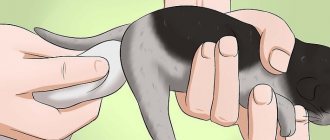5701Administration
Cats are not always tame and affectionate. Because of this, some owners are interested in how to accustom a kitten to being held, so that in the future the furry pet remains affectionate and always ready for human contact. Accustoming a cat to being handled when it is already an adult can be much more difficult, so this should be done with a kitten as soon as it settles in the house. In order to achieve success, you need to know certain rules of training, because otherwise, by making mistakes, you can get the opposite result and instead of a sociable cat, raise a wild animal that will react aggressively to attempts to pick it up.
How to tame a wild kitten
Future owners are worried: how to tame a kitten, what if the situation gets out of control and an unaffectionate cat will grow out of a cute creature. The baby quickly gets used to it and begins to understand:
- Where is the toilet.
- Where is the bowl of food?
- Who lives in the family, from whom you need to hide.
To tame a cat you will have to wait ten days (maximum). Usually this much time is spent on re-educating a street dweller.
It’s worth learning from the very beginning: a kitten’s squeak means “I feel bad,” while purring is a sign of goodwill and contentment.
There is no need to push a squeaking lump into a bathtub of water or allow children to cause pain. The kitten should feel safe and loved. It’s easy to accustom a kitten to handling and rules of behavior (both in the house and at an exhibition): affection, play and treats will do.
Once the baby is in the house, you need to give him time to calm down. You can leave him in an unlocked cage or put him in a low cat basket. Don't forget to place a bowl of water nearby.
In a calm environment, the kitten will soon crawl out of its shelter and go to inspect the territory of the house. Don't pick him up just yet. It is enough to gently stroke him and say a few words in a calm tone. Then transfer to a bowl and praise. In this case, the kitten in your hands will not perceive the action as danger.
Within 24 hours, the cat will begin to trust its owner and may jump onto its lap. The kitten will learn to sit quietly in your arms if you support it by its back. The warmth of the hand is soothing, and any possible fear of heights disappears.
At what age should you adopt a kitten to make it easier to raise it?
Breeders recommend adopting kittens at the age of 3 months. By this time, the baby becomes independent and it is easier for him to part with his mother. A kitten that has not experienced severe stress from a change of home will be more contactable with humans. A raised animal has a lot of advantages over a baby.
:
- the kitten is already socialized and ready to learn;
- the animal is accustomed to the tray and scratching post;
- some of the cats have already been neutered, so they are more affectionate towards their owner;
- the animal knows the rules of behavior in the house.
It will be easier to raise a grown cat than a 1-2 month old baby. The animal is already socialized, so the learning process will not be difficult. When choosing a pet in a breeder's home, give preference to friendly, affectionate kittens who will make contact themselves.
How to accustom a cat to hands and affection
If you want cat affection, become patient and affectionate yourself. An outdoor cat will begin to trust a person when it gets used to his smell and voice. He will associate his appearance with a pleasant event (food, affection).
A wild cat is tamed in the same way as a kitten. First, treats are brought regularly. Then they hold out their palm with a piece of the most delicious thing (the delicacy lies in the center of the palm, not on the fingers!), and allow it to be sniffed. When the cat begins to approach, perhaps rubs its head on its leg, you can pet it in response, speaking calmly and affectionately.
A common mistake: in order to tame a cat at home, he is immediately locked in a room - the animal will try to escape as soon as it is freed.
You can call the cat with you, after a few meters, stop, praise, and give a treat again. The main thing is that if you come, give her the opportunity to leave. Without feeling afraid, the pet will return.
The main rules of education
For good parenting, it is important to understand the psychology and worldview of a cat. An animal lives according to its own principles; it is important to take into account its natural needs and inclinations. Therefore, it is important to study the individual characteristics of your pet and act based on them in the future.
One of the most important rules for raising a kitten is to respect its love of freedom; not all cats are loyal and loving to their owners. But this does not mean that cats are allowed everything; it is important to find a middle ground when both the owner and his pet feel comfortable. The basic principles of raising a kitten include:
- Taking into account the innate egoism and practicality of the animal - in the process of education, it is not allowed to affect the animal’s pride, it is not allowed to humiliate and insult it, otherwise the cat will become withdrawn and aggressive. It is also important to take into account the practicality of cats - they will never do anything for nothing if they do not understand their benefits and benefits from this action. Therefore, in order for the pet to stop certain actions, the owner needs to prove their impracticality and offer something else that is better and more pleasant for the cat.
- Cats are characterized by waywardness and selfishness, so it is important from the first day to show who is boss in the house and not follow the animal’s lead.
- It is important to avoid the following mistakes:
- scream at the kitten or hit it;
- do actions that will make the kitten afraid of you;
- humiliate the kitten, poke its nose into a puddle and take it by the scruff of the neck.
All these actions cause resentment and aggression in the pet; in the future, he can take revenge and grow up with nervous disorders. The keys to success are affection and kindness. Commands need to be spoken in a clear and confident voice; it does not have to be raised so that the animal listens and understands that this cannot be done. Kittens can learn, but it takes a lot of time and patience.
- You should not let your kitten sleep in your bed
- the greatest concentration of odor accumulates in the place where it sleeps. When a kitten sleeps with its owner, it begins to feel like an equal with him and does not recognize his authority. It is better to arrange a separate place for the purr to sleep, and you need to accustom him to it from the very beginning. - It is important to pay attention to the kitten
, otherwise it will run wild and stop obeying as a sign of protest. Babies especially suffer from lack of attention, so take time to play with him and cuddle him. Then he will trust you, and you will become an authority for him. And besides, by distracting him by playing with special toys, you can be sure that he will not do any mischief.
Why is the cat not affectionate?
If a cat scratches and bites as an adult, the owners themselves are to blame. While still playing with her, they allowed her to “claw” in excitement. At first it's funny, then the adult:
- bites legs;
- does not allow himself to be combed;
- spoils things, marks territory.
The simplest veterinary examination and medical procedures (injections, enemas) turn into a nightmare for the owner.
The independence and aggressiveness of a mustachioed cohabitant should not be shown towards family members. If the owners are afraid, the pet will become impudent. It is recommended to hold the cat in your arms more often and show affection. After taming, release it for further exploration of the area, praise and treat it with something tasty for good behavior.
Gradually the cat will understand: nothing bad is happening. If you do this regularly, at the same time talk affectionately, give a piece of “yummy” - after a while you can add short-term combing, examining the ears and other manipulations.
An irrepressible desire to “cuddle” can also be the reason why a cat becomes less affectionate. Small children will happily play with the kitty and pull its ear or tail.
Adults sometimes don’t lag behind (especially if the cat is not their property): they shamelessly shove pieces from the table, try to stroke them and pick them up against their will. It's not the cat that needs to be blamed, but the owner:
- If the cat is not the highlight of the program, it is better to isolate it in another room. Or warn the guest about correct behavior.
- For children, it is better to find other fun, otherwise the simplest scratch on the hand of an uncontrollable child will ruin the evening.
- When neither the person nor the cat is particularly anxious, let them interact as they wish.
Advice. It is advisable to wash your hands not only after interacting with an animal, but also before. Precautionary measures apply to small unvaccinated kittens.
The selection of some breeds followed the path of consolidating external characteristics. Such cats are more attached to the territory than to the owner. For example, bobtails and Norwegian forest cats do not recognize excessive affection.
It is better to choose a Burmese, Siamese, Sphynx or Rex or an ordinary yard cat - a “mongrel”. “Human-dependent” cats can hardly tolerate loneliness, they are easy to tame and they love the affection of their owner.
What do experts recommend?
You need to gradually accustom your cat to human contact. It is very important that your pet feels comfortable and safe. To prevent the kitten from being scared of you, it is important to speak to it in a monotonous and soothing tone. Take a closer look at the following tips if you are faced with the need to accustom your cat to affection:
- Start with normal touching. Approach your cat several times a day and scratch it. At first she may get scared or run away. Usually, untrained animals simply show dissatisfaction. Short strokes with the spoken phrase “good boy” and other pleasant words can smooth out such a situation;
- Use a treat. Every pet has food that it is very partial to. At first, you can sit on a chair, taking a treat with you. Call your pet over to give him some food. Wait until he jumps into your arms. This method is good when the cat is already accustomed to your stroking;
- When a kitten has a favorite toy, you can try to interest him in such entertainment. You can use a soft ball, bows, and items purchased from a pet store. It is important that the item used does not damage the animal’s teeth and oral cavity;
- Teach your pet to eat from your hands. Right away you can simply give small pieces of food, and then feed and pet the animal at the same time.
The most popular methods for teaching a cat to be handled are listed above. Of course, it is necessary to take into account the individuality and uniqueness of each pet. Representatives of the cat family love to be taken care of. To reach this level of relationship with your pet, sometimes you need to try and be patient. But it also happens that a cat shows a friendly attitude towards some people, but is wary of others. In this case, we recommend that you resort to the same methods and give the kitten the opportunity to gradually get used to your loved ones. It is much more difficult to train an adult animal, since it has already formed certain patterns of behavior. In order to change your pet's habits, you need to develop a special approach to it.
Is it possible to tame an adult cat to a new owner?
A cat tolerates a change of owner more easily than a dog. The exception is socially oriented breeds, for example, Oriental Siamese. They will gradually become affectionate with their new owners, but the first one is the only one for life.
The best way to train, even for a sexually mature individual, is not food, but play. First, an adult cat must get used to the territory. It is better to leave your pet to explore its new home on its own, and after a while offer some food from your hands. Just like a treat. At the same time, do not forget to talk measuredly, but not to stroke.
As soon as the cat gets used to it a little, you can:
- lightly scratch a chair or furniture - so that the cat reacts to the sound near the owner;
- roll a ball or ball of wool near you, inviting you to play;
- “drive” a candy wrapper.
The cat quickly joins the game. After a while, you should again give a piece of food from your hand and praise it.
Praise and Punishment
Anyone who has wondered how to raise a cat has wondered how to properly use rewards and how to punish in case of inappropriate behavior of their pet. Incentives can be of several types:
- stroking the cat;
- treat;
- games;
- verbal praise
- weasel.
For an adult cat, punishment and reward are the most effective way to train. The animal must also be punished correctly. Physical violence must be completely excluded. You can show the swing with a newspaper or magazine, but not execute it. You should not do this with your hands or your palms.
The punishment should not be delayed, so the cat will not understand why exactly it was done. Inevitability should also be an important principle. If a cat is stealing, it is necessary to punish for each episode, and not selectively. Only in this way can a disobedient animal be corrected and such behavior prevented in the future.
Is it possible to hit a kitten?
You cannot hit a kitten or an adult cat. Such actions can lead to the opposite effect; the cat will try to take revenge. This is especially noticeable with some breeds. Violence and physical force destroys contact with the animal. A stern voice is the best substitute for brute force.
Games with a kitten
Be sure to play with the kitten. Friendships are established in the game. Do not use your arms and legs to play, otherwise, as an adult pet matures, it will painfully dig into your body, causing a lot of unpleasant sensations.
To play, use special toys, these can be balls, fluffy balls, mice, etc. The main thing is that the toy is made of safe materials and does not have small parts that a kitten can swallow.
Do not let the kitten climb on you, catching your clothes and scratching you; as an adult, you will no longer wean your pet from ruining your things.
When to start raising a kitten, how and what to teach it
The optimal age for parenting occurs immediately after the adaptation period. Be attentive to the kitten's habits if it is more than 3 months old. It is extremely important to correct your pet’s behavior gently, in a playful or rewarding way.
.
Don’t even think about hitting a kitten for training purposes; this will make your pet more nervous and timid, but not at all obedient. Avoid stressful situations
until the kitten is 6 months old:
- Frequent arrivals of guests, noisy parties or celebrations. Yes, it is a sacrifice, but it is made to strengthen your pet's psyche.
- Walking on a leash is of no use to the baby; he needs to fully explore the home, every cabinet and every shelf. In addition, a pet that has not received it should not come into contact with street animals, this is fraught with viral diseases, sometimes fatal.
- Punishment - at this age, the kitten is very pliable and its behavior must be corrected exclusively with positive motivation.
Cats are very receptive to training until they are one year old.
, this period is quite enough to master basic skills. The first priority is this. On the very first day, keep an eye on the baby, as soon as he starts to “fumble” in search of the toilet, transfer him to. If you don't have time, quickly blot up the puddle with a paper napkin and place it in the tray. Even 2-month-old kittens have a keen sense of smell and rely on it when searching for a litter box.
Important!
If you have multiple cats in your home, get extra litter boxes! Firstly, each pet should have its own toilet, and secondly, do not forget that some cats go to different litter boxes - big and small.
Try to take the kitten
to the toilet 15–20 minutes after feeding
and stay with the baby until he relieves himself. It is worth refraining from frequent cleaning of the tray, since fresh litter does not have a characteristic odor. Keep the trophy napkin (or replace it with a piece of cloth), praise your ward every time until the habit of going to the litter box is established.
Basic principles of interaction with an independent adult cat
The appearance of an experienced adult animal in the house is always associated with the risk of confrontation between it and the new owner. Veterinary psychologists were able to identify several rules for the owners of such cats, following which the complex nature of the pet can be slightly softened:
- You should remain calm under any circumstances. It just so happens that an adult cat with a difficult past is unlikely to ever be able to become an affectionate and playful pet. If life has strengthened his character, he will often and scrupulously test the strength of his master, as if bringing him to emotions. Lack of trust in human kindness and affection is difficult to restore. The cat can mark corners, tear up furniture and openly ask for a spanking. You should treat such outbursts with understanding, never physically punish the animal or raise your voice. Strictness, iron grip and care will be good helpers in communicating with such pets.
- You should never look straight at a cat. In the animal world, such a maneuver is interpreted as a challenge and a struggle for dominance. The owner has absolutely no need to prove who is in charge in the apartment. If a cat allows itself to be stroked, there is no need to make sudden movements, speak loudly and closely observe its reaction. It’s better to do it casually, as if such affection has long been in the order of things. It is quite possible that this will happen soon.
- Do not touch your cat in places where it is uncomfortable. You can only find out her preferences through experience, and the pet definitely won’t like it. Areas that rarely cause discomfort are the area between the ears, under the chin and the bridge of the nose. Touching the stomach and the area at the base of the tail will definitely cause negativity. If the cat is an adult, has a history of trauma or abuse, you need to be especially careful to monitor its reactions. It is quite possible that even “pleasant” areas will be prohibited for affection.
- Daily grooming will help build friendships. You need to choose a procedure that your cat will like. Perhaps this will be a daily combing of the fur and a calm conversation at the same time. Carefully monitor the reaction to each action and do not delay the process, even if it brings pleasure to both the owner and the cat.
- Rewarding good behavior. At the stage of leveling up a difficult character, it is important to regularly reinforce trust and praise the cat, encouraging him with treats. Even if the glimpses of trust are very small, for example, a pet wants to sit next to you, it is still worth encouraging. In the end, it will come to sitting on your knees and asking for affection, but after some time.
The best motivators for interaction are games and toys. Maintaining the hunting instinct helps to establish friendly relations like nothing else. And patience and acceptance of your pet’s character will help you achieve a positive result faster.











